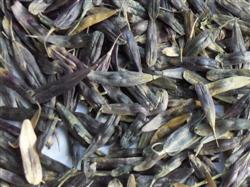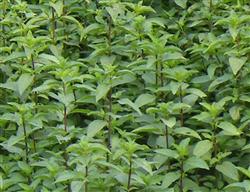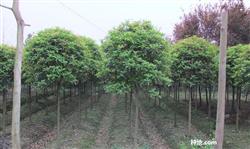mint blight

Latin name: Sclerotium rolfsii Sacc. Harmful crops: symptoms of menthol damage: the upper leaves of the diseased plant were discolored at the beginning of the disease, and there were a large number of white mycelium and brown rapeseed sclerotia in the stem base and intersoil, which led to the weakening of plant growth, withering or death of the whole plant after the expansion of the disease. Morphological characteristics of the pathogen: on PDA medium, the mycelium was white, yellow, and radiating; the mycelium was 2-8 microns in diameter, the branches were not at right angles, with septum; the sclerotia was milky white at first, then became light yellow to tea brown or brown, globose to ovoid, 1-2mm in size, and the surface was smooth and shiny. The surface layer of sclerotia consists of three layers of cells, the outer layer is brown, the epidermis is pseudoparenchyma, and the middle is filamentous tissue. Taxonomic attribute: it is called Roxanthium, or Sclerotinia uniformis, which belongs to the distribution area of half-known subphylum fungi: Jiangsu, Anhui, Guangdong, Sichuan, Yunnan and other provinces: the pathogen overwintered in the soil with the disease residue through the hyphae or fungal cords, and when the conditions were suitable in the following year, the sclerotia or mycelium produced hyphae for primary infection. The silky filamentous hyphae produced by diseased plants extend to contact with adjacent plants or sclerotia are re-infected by water transmission, resulting in the spread of the disease. Continuous cropping or clay weight of soil and low-lying or high-temperature and humid years or seasons. Prevention and treatment: avoid continuous cropping in seriously ill areas. It is recommended to apply Japanese enzyme bacteria retting fertilizer or fully mature organic fertilizer. Check in time, remove and burn the diseased plant in time. The disease point and its adjacent plants were irrigated with 5% Jingangangmycin water agent 1000-1600 times, 50% tianan water agent 500,600 times, 20% methyl rifampicin EC 1000 times, 90% dimethophos wettable powder 1000 times, each plant was irrigated with 0.4-0.5L. Or mix it with 40% mixed seed Ling and fine sand to form a 200-fold medicinal soil mixed with diseased soil, 100-150 grams per hole, once every 10-15 days. With 0.4-0.45 kg of cultured Trichoderma harzianum and 30 kg of fine soil, mix well and sprinkle on the base of the diseased plant. Stop taking medicine 5 days before harvest. Commonly used agents: 5% Jingangmycin water agent 50% Tian'an water agent 20% methyl rifampicin EC 90% dimethophos wettable powder 40% mixed with seed ling.
- Prev

Management of mint before and after emergence
According to the practice of large area mint cultivation for many years, strengthening the field management before and after emergence of mint seedlings is an effective measure to achieve high yield, high quality and high efficiency. It can increase the yield of peppermint crude oil by 1.5 kg per mu, with a net profit of about 100 yuan. First, clear the ditch to regulate the moisture and reduce the humidity in the field. Peppermint is afraid of drought and is not resistant to water.
- Next

What problems should be paid attention to in the transplantation of sweet-scented osmanthus trees?
What are the common diseases and insect pests in sweet-scented osmanthus trees? How to prevent and cure? The common diseases and insect pests of sweet-scented osmanthus trees are as follows: 1. Leaf spot: the leaf spot is mainly harmful to the leaves, the disease spot is brown, the disease spot is round or irregular, the center is gray to gray in the later stage, the edge is reddish brown, and the disease spot produces black-gray mildew. High temperature and humidity are often.
Related
- Fuxing push coffee new agricultural production and marketing class: lack of small-scale processing plants
- Jujube rice field leisure farm deep ploughing Yilan for five years to create a space for organic food and play
- Nongyu Farm-A trial of organic papaya for brave women with advanced technology
- Four points for attention in the prevention and control of diseases and insect pests of edible fungi
- How to add nutrient solution to Edible Fungi
- Is there any good way to control edible fungus mites?
- Open Inoculation Technology of Edible Fungi
- Is there any clever way to use fertilizer for edible fungus in winter?
- What agents are used to kill the pathogens of edible fungi in the mushroom shed?
- Rapid drying of Edible Fungi

